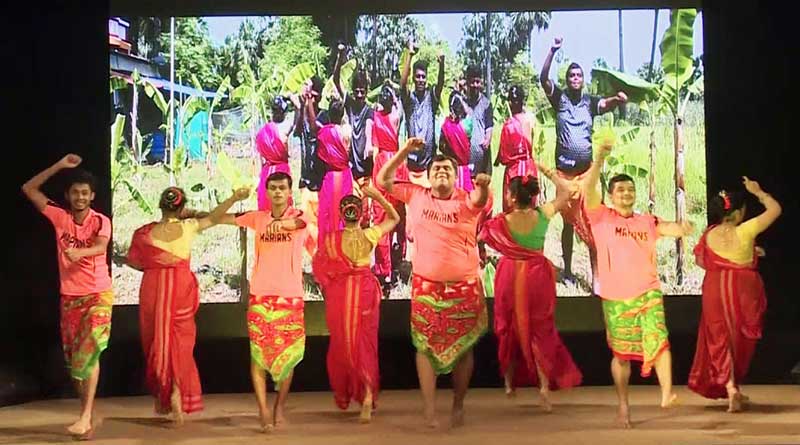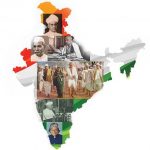The East Indians: An enduring image

“Eh poree kaun ache…” is a lively melodious song that originated in the East Indian community and literally means “Whose little girl is this…?” and is usually sung at East Indian weddings. Without knowing its meaning or purpose, it is randomly played by all and sundry at every possible occasion irrespective of its relevance.
Origins of the community
Feed the family well and half the battle is won,” they say. The East Indians know it too well. East Indian cuisine is rich, flavourful and especially appreciated at weddings and on feast days. Getting recipes from the community is a daunting task, as families guard their recipes closely and seldom have them in print. Mothers pass them on to their daughters and rarely to their daughters-in-law. But times have changed and there are about a dozen cookery books published down the years: the East Indian Cookery Book (yellow cover, 1981) is treated as a sacred book.
Bottle masala is a special blend of spices that East Indians make every summer, a ritual that is still being enforced in far off suburbs like Vasai, and even in places like Bandra. A look at its potent red shade and you can assume it would be dynamite, as many families use around 30 ingredients, from Kashmiri chillies to kebabchini (allspice), nagkesar bulbs, mugwort (maipatri) and lichen (dagadful). In crowded cities, we find terraces and courtyards where spices are kept out for drying; later a group of women visit the homes to prepare the masala.
The women come with long poles and earthen pots. They roast and combine the spices in the proportions prescribed by each family’s recipe, and then, pounding rhythmically the poles in the pots, reduce them to powder, and put the masala in beer bottles for use for the whole year. Why beer bottles? Because, as they have a dark glass, the sunlight doesn’t spoil the spice powder; secondly, there’s never any shortage of these bottles in any East Indian family. Bottle masala makes almost any dish taste good, with the other ingredients, without dominating them.
Then, there are curries like Mutton/Chicken Khuddi, Lonvas (mutton and pumpkin), Fritath, Gizad or even Bombay Duck (Bombil) with either boiled rice, chitaps (rice crepes), aps (rice bhakri). Rice is presented in a variety of preparations, and in festive seasons you also find fugias, wadds, polias, chatiaps and sannas. To try out any of these dishes, one can always visit Bottle Masala, a restaurant serving authentic East Indian cuisine, in Manori, north of Mumbai.
Wine and liquor play a significant role: khimad (Queimada) is a popular drink, intoxicating, also known for its medicinal value. As for sweets, there’s Atola, Sanna, Umber, Banana Fritters, Chatch (sweet potatoes); for Christmas there’s Navries, Kulkuls and Marzipan.
East Indians are the descendants of the indigenous Marathi-speaking people of Mumbai and its environs who embraced Christianity in the period 1547-1600. Though drawn from diverse social groups, they developed a ‘consciousness of kind’ over the centuries, chiefly due to the common religion they professed.
While the masses remained rooted in the rural soil, retaining their Maharashtrian characteristics, the lifestyle of the urbanized sections of the community was gradually transformed due to Portuguese and English influence. They are the original Mumbaikars, and being original inhabitants hail from Salsette, Vasai, Thane, from Dahanu in the north to Chaul near Alibag in the south.
They were generally identified by their occupations, such as Kunbis (land owners/agriculturists), Bhandaris (toddy tappers), Agries (salt pan workers), Sonars (goldsmiths), etc. To distinguish them from the migrants who came north from Goa and Mangalore, they assumed a new identity and were called ‘East Indians’. The designation ‘Bombay East Indian’ was adopted on the occasion of the Golden Jubilee of Queen Victoria in 1887 by the leaders of the community.
In fact, the foundation of the East Indian community was laid when thousands in the area from Dahanu in the north to Chaul in the south embraced Christianity. People of a particular pakhadi (hamlet) assumed the same surname, as can be seen from the gravestones and the registers of baptisms, marriages, etc., in the old churches. They assumed Portuguese surnames and not ‘Christian’ ones as is often understood.
Those who became Christians were from various social groups like Samvedi Christians, Vadvals, Koli Christians, Salsette Christians, and the urbanized group. The last is in many respects similar to the Salsette Christians. The difference lies in the fact that they received an education in English, being influenced by the English rather than the Portuguese. It is also said that the label ‘East Indian’ came about since the community members, who had mastered the Roman alphabet, thanks to the rudimentary schooling introduced by the Portuguese, were the first to seek employment with the East India Company as clerks.
They inhabit areas like Khotachiwadi, Mazagaon and Matharpakhadi, Dadar, Wadala, Mahim, Worli, Parel, Manori, Gorai, Uttan, Bhayandar to Thane and Vasai (Bassein). The people of Vasai are proud to have their own saint. St Gonsalo Garcia was born around 1557 in the coastal town of Vasai. He was martyred in Japan and beatified in 1627. Pope Pius IX canonised him a saint in 1862. The original church of the saint still exists in Vasai and his feast is celebrated on 5 January.
While Maharashtrians speak pure Marathi, in the East Indian community, the Marathi language has different dialects, from those spoken in different areas inhabited by the community. The monthly magazine for the villages, gaothans and koliwadas of Mumbai, Thane, Vasai and Raigad district is Mumbai Gaothan Voice (MGP) which is doing all that is possible in uplifting the community. They also have been organising various programmes to bring together members of the East Indian community not only from Mumbai, but from the U.S., Canada, UAE, New Zealand and Australia, too.
Festivals, dances, celebrations

East Indians do keep alive traditional festivals like Agera — the East Indian Harvest Festival — and other important ones. They recently released an East Indian dictionary, an East Indian calendar, and regularly hold the annual East Indian Awards function to honour community members. In addition, they have also an East Indian Museum in Manori.
Maharashtra, like any other state in India, has its popular dances: Lavani dance, Povadas dance, Koli dance, Tamasha, Dhangari Gaja, etc. However, the Koli dance is more popular among East Indians, evident reason being the community’s proximity to the sea and fishing.
The dance is done by men and women divided into two groups. Men stand in two rows with oars in their hands, while women come with their linked, and moving towards the men folk. Then they dance together with movements symbolising waves, bvrakers rowing from cliff to cliff, casting nets to catch fish.
Marriage celebrations of the community are unforgettable with nankhatai band (brass band) in attendance and guests dancing. The rejoicing starts from the day the first “banns” are announced in the church. A pandal is erected at home, much before the big day; then there is the customary umbrachpani, the day before the wedding, that winds its way to the village well from where water is drawn for the bridal couple’s purificatory bath on Sunday morning. The external celebration ends with the jhetar — a sumptuous dinner for all those who attended the wedding, and presented gifts.
Dress and jewellery
The traditional East Indian sari is plain and simple, nine to ten yards long comprising small checks, edged with two borders known as kastyache. Colours vary from red to green, with the Samvedis using deep red, to the Bhandaris who use green, and the Kumbis who use dark blue. Widows wear dark blue. The jewellery is quite elaborate and mostly made of gold.
Bombay East Indian Association

In order to safeguard the interests of the community and enable progress in the future, they had to be united under one umbrella and this took the shape of the Bombay East Indian Association on 26 May 1887. The Association has taken the community to higher peaks in education and employment and ensuring also their civic duties and rights.
The current six elected committee members are designated the Transformation Team under the guidance of Dr (Mrs) Cheryl Misquitta, a renowned medical practitioner. As President, Dr Cheryl has taken upon herself the responsibility of mentoring her team in order to implement new ideas intended to make the Bandra Gymkhana more vibrant.
At the time of the Association’s Golden Jubilee in 1937, Dr D. A. D’Monte was the President. The jubilee celebrations, held on the grounds of the present Bandra Gymkhana, were inaugurated by the then Governor of Bombay, Lord Brabourne, accompanied by Lady Brabourne.
Dr D’Monte’s generous donation of a plot in the Salsette Catholic Co-operative Housing Society’s area, and another donation of the adjoining plot by J. R. Athaide, a well-known advocate, led to the founding of the Bandra Gymkhana on 4 November, 1933.
Several eminent personalities have been at the helm of the Association: Alfred D’souza was in office at the time of centenary celebrations in 1987. Prof. (Mrs.) Lilla D’souza, an eminent educationist, was the President at the time of the 125th anniversary celebrations, and was instrumental in streamlining the annual Awards Presentation, and introducing career guidance seminars for the students.
The Association has contributed a lot by obtaining OBC status in the field of education, in addition to encouraging the youth to seek higher education and professionalism through career guidance seminars and scholarships. The BEIA annually organises its social and cultural festivals with songs, dances and an East Indian dinner. At the last Festival on 5 May 2019, the writer was among the five felicitated for their meritorious achievements.
Stalwarts of the community
Cardinal Simon Pimenta was the second prelate to be named a Cardinal from the Archdiocese of Bombay, and the first Cardinal from the East Indian Community. Born on 1 March 1920, he became the Archbishop of Bombay in 1978, and was named Cardinal on 28 June 1988. A regular reader of The Teenager, even after his retirement, he led the Archdiocese for 18 years. Cardinal Pimenta passed away on 19 July 2013.
Msgr Nereus Rodrigues, one of the senior-most priests of the Archdiocese of Bombay, and a renowned educationist, is fondly remembered for his hard work in establishing St Andrew’s College, Bandra. He was the College’s first Principal, and Managing Trustee, too. He also played a major role in averting the untimely closure of Holy Family Hospital, Bandra, in the late 1970’s. He turned 95 on April 5, this year, and resides at Mount Mary’s Basilica.
Padma Shri Fr Joe Pereira is well-known for his work for the rehabilitation of HIV patients and those affected by substance abuse. Founder and Managing Trustee of Kripa Foundation, he is a certified yoga instructor, and a member of the New York Academy of Sciences.
Barrister Joseph Baptista, London-educated, is the father of the “Home Rule Movement.” He put out the idea of “Freedom is My Birth Right”. He was a close associate of Bal Gangadhar Tilak, a nationalist and freedom fighter. The two worked very closely, and so Tilak insisted on Baptista handling his defence in 1907, when he was prosecuted for sedition. Baptista remained genuinely interested in the plight of workers, who affectionately called him ‘Kaka’.
J. B. D’souza was a bureaucrat known as a ‘Man of Steel.’ He is one of the giants in Maharashtra’s bureaucracy, who stood up to political bosses fearlessly on many occasions. He was the first IAS officer to become Chief Secretary of Maharashtra, and also held several key positions including General Manager of BEST and Municipal Commissioner. He also had stints with the International Monetary Fund and World Bank.
H. J. D’Penha was Principal Information Officer, Government of India, and Press Advisor to Prime Minister Indira Gandhi, while Lancy Gomes has served on major warships and submarines in senior postings and was India’s naval attache to Pakistan and Deputy Chief of Protocol, MEA.
Master Willie D’souza was a renowned school teacher and an educationist. He crossed 100 years of age with a very active mind. His daughter, Prof. (Mrs.) Lilla D’souza followed him closely as an educationist and became the Principal of St Andrew’s College, Bandra.
Prof Louis D’Silva, a well-known author, compiled The Christian Community and the National Mainstream which was released by President Zail Singh in 1978. Six editions of the book were published during the period 1978-1981.

The Sequeira Brothers have put Giriz, Vasai, on the world map with their religious wood carvings that have not only been erected in the churches in India, but also in the U.S., Canada, Spain, Malaysia and other countries.
In Sports, the community has Padma Vibhushan World Billiards Champion Michael Ferreira, and Olympics Hockey champ Marcellus Gomes, in addition to Olympic hockey players Gavin Pereira and Joseph D’Abreo. Hilary Gomes has literally given an arm and a leg to sports with his versatility in varied sports. Mark Joseph Dharmai has made India proud as a para-athlete who won a bronze medal in the 2017 Doubles BWF Para-Badminton World Championships.
Need an ideal gift to introduce someone to the East Indians? What better way than advertising in veteran Neville Gomes’ coffee table book Viva, Queimada, a virtual encyclopaedia on the East Indians. Jude Gomes, a prolific writer and traveller, now edits the East Indian Journal. Advertising guru, Roger Pereira, became the toast of the advertising industry excelling with great brands and winning awards. Clarence Gomes, editor of Bandra Times, a popular community newspaper, won the Maharashtra State Award for his phenomenal work with visually disadvantaged people working with National Association for the Blind.
With no intention ever to enter the film industry, Genelia D’souza emerged as one of the few self-made actresses of Bollywood. There’s also VJ and TV personality Maria Goretti, musicians like Ashley Quiney and Crompton Tixeira, songstress Nancy Netto, who have kept alive the culture of East Indian music. Roger Drego is known for his unique contributions in making international music concerts sound right, be it at St Andrew’s Auditorium or live shows across the country.
James Ferreira, Indian fashion designer and son of hockey Olympian Owen Ferreira, too, has won many laurels in his field and is considered a name to be reckoned with. Tu Maza Jeev, a film done in the East Indian dialect by Nelson Patel, an East Indian from the Kharodi village of Malad, was released in 2009, and became a runaway success.
Here’s wishing you good luck, that when you next meet an East Indian, you would know who you are talking to!
(With inputs from Verus Ferreira)
Irwin Almeida is a senior journalist who worked with The Indian Express and was a former editor of the East Indian Journal.


